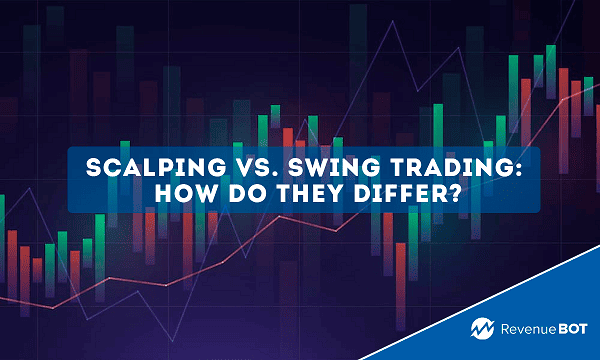
In the world of investing, there is a plethora of strategies available for traders to utilize in order to fulfill their financial goals. Among the numerous approaches, swing trading and scalping are of particular regard. These two strategies offer traders some unique opportunities to maximize their profit from the financial markets.

They are also vastly different. While swing trading requires a lot of time and patience on the part of the investor, with a small number of trades executed. Scalping, on the contrary, focuses on short-term ones.
What exactly is swing trading?
This strategy is one-of-a-kind, since it focuses on capturing short-term price fluctuations. Swing trading differs from all the other techniques due to its ability to identify and harness trends on larger timeframes. But you should not confuse swing trading with HODL “hold on for dear life” straregy, when a trader buys an asset and holds it for an extended period of time. In fact, the basic idea behind swing trading is to capture the “swings” or fluctuations in price charts that occur within an established trend.

Unlike scalpers, swing traders do not seek to capture every single moment of market activity. Instead, they focus on more dramatic price movements that may last for days or even weeks. This allows traders to benefit from long-term trends while minimizing the impact of nondurable market volatility.
Moreover, swing trading takes a deep knowledge of market analysis as well as the ability to identify entry and exit points. Risk management tactics play a vital role in swing trading as traders seek to generate as much profit as possible while maintaining a minimum level of risk.
Such an approach is suitable for those who prefer a more laid-back pace and are willing to wait for results over a longer time span.
What timeframe is better for swing trading?
Choosing the right timeslot is a key element of successful swing trading. It depends on the timeframe at which moment a trader might analyze price behaviour and make decisions about whether to participate in the trading process or not. Each timeframe has its own peculiarities, so the proper choice will vary according to the trader’s individual preferences, trading styles and objectives.
- Long-term timeframes (weekly, monthly): these are great for traders who prefer a larger time horizon. Analyzing weekly or monthly charts enables you to identify long-range patterns and form strategies based on them. However, it demands great patience, as signals on such timeframes may appear less frequently.
- Medium timeframes (daily, 4-hour): such charts provide you with a balance between long-term and shorter-term timeframes. Traders who choose this one can receive signals on a more frequent basis, while still being able to spot long-lasting trends.
- Short-term timeframes (1-hour, 15-minute): As for short-term ones, they are suitable for more energetic traders eager to respond to immediate market fluctuations. Still, it requires closer monitoring and quicker action as the situation changes.
Choosing a timeframe also relies on the market volatility and the trader’s degree of comfort in dealing with various types of timeframes.
What is scalping?
This method involves entering and exiting a trading position over an extremely tight timeframe – lasting from a few minutes to a few seconds. Scalpers strive to capitalize on the slightest price developments, regardless of long-term trends or fundamentals.
This kind of traders also actively use tick and candlestick charts to catch instantaneous shifts in price. So analyzing trading volumes and responding rapidly to momentary market events both become an integral part of a scalping strategy.

The strategy in question asks high focus and a fine-tuned risk management system. Scalping positions can be opened and closed many times over a short period of time, so knowing how to make swift decisions to Stop-Loss and Take-Profit constitutes a critical element of successful trading.
Technical analysis skills matter in scalping quite a lot. Scalpers employ a broad spectrum of technical indicators to detect entry and exit points. Fast and accurate calculations form the basis for decision making under fast-paced market conditions.
Which strategy is better?
Whether to choose swing trading or scalping, it is entirely up to you, base yourself on the goals, how comfortable you are with taking risks, and your personal tastes. Should you opt for a more relaxed approach, want to analyze the market over longer time frames, and are willing to anticipate the outcomes, swing trading may be a more appropriate choice. On the other hand, if you enjoy speedy and dynamic trading and are prepared to make split-second decisions, then scalping may suit you even better.
It is also essential to consider your level of experience. Some traders prefer to start with longer-term strategies, such as swing trading, and only then gradually move to shorter-term approaches, like scalping.
Conclusion
The trading strategies discussed in this article have their own strengths and distinctive features, so, as said, the right choice is determined by one’s individual goals, trading style, and level of experience.
Swing trading is a chance to discover and exploit long-term trends, emphasizing the resilience and patience of any given trader. Scalping, by contrast, dictates an in-the-moment reaction to short-term price swings, highlighting quick decision-making and stress tolerance.
Regardless of your choice, successful trading hinges on a thorough comprehension of the market, rigorous risk management and relentless skill development. Investors should bear in mind that both strategies can yield high returns, however, the key to success lies in picking the style that fits their individual needs and purposes.
